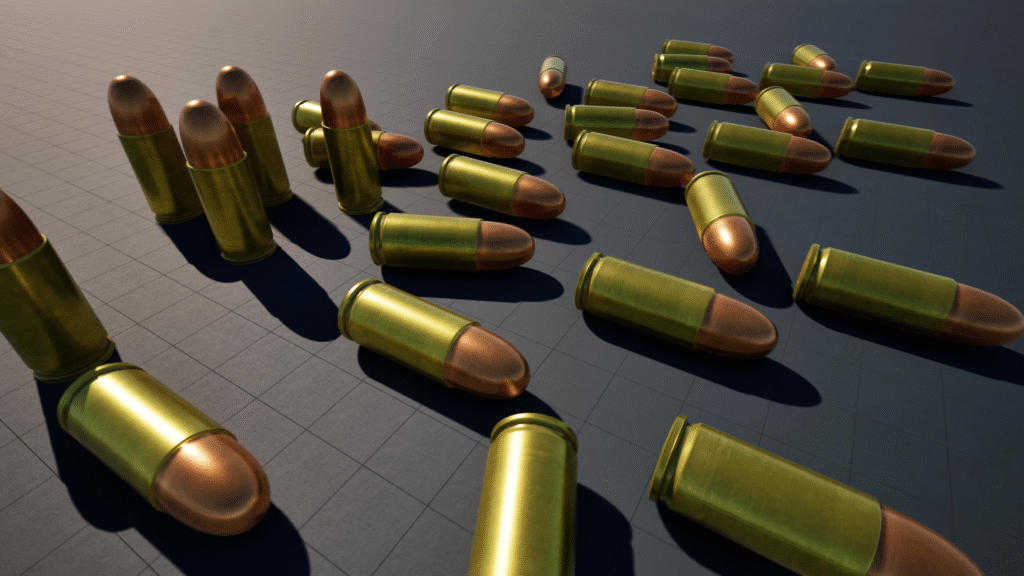
Have you ever picked up a bullet and wondered how something so small can be so powerful? Or maybe you’ve seen bullets in movies and thought — does the entire thing fly out of the gun when fired?
You’re not alone — many people assume that the entire shiny object called a “bullet” shoots out of the barrel. But the truth is quite the opposite! Only a tiny portion of what we call a “bullet” is actually the part that flies toward the target.
So how does it really work? How does pulling a small trigger create such massive force and speed? Let’s break it down, step by step.
Watch the Full 3D Animation
This blog is based on our 3D animated YouTube video.To explore all of these processes in 3D, check out our detailed YouTube explanation linked at the end of this blog — and don’t forget to subscribe for more insightful videos! (Available in Englsh & Malayalam )
What Is a Bullet, Really?
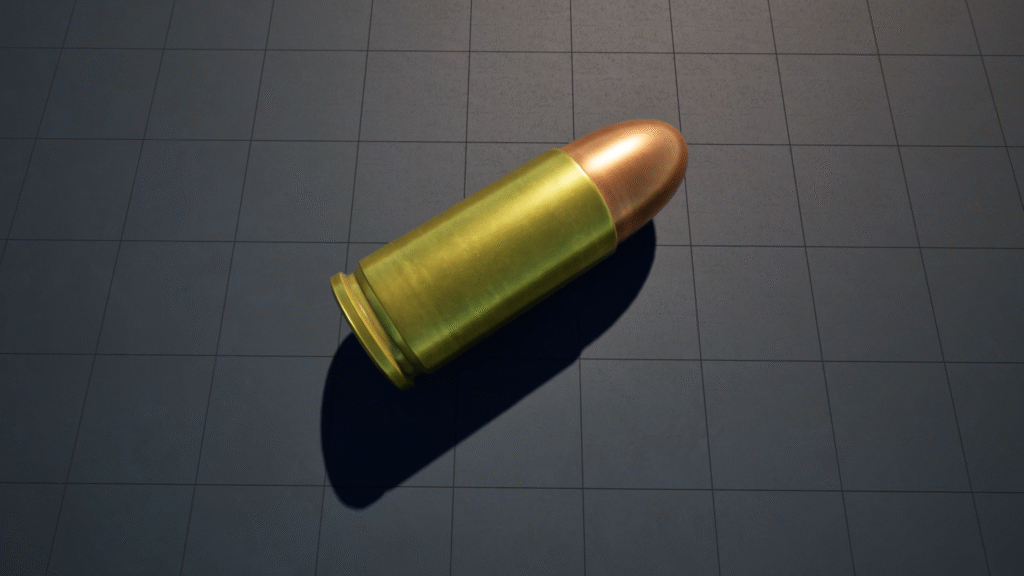
When most people say “bullet,” they’re usually referring to the entire metallic piece you load into a gun. But in technical terms, that complete unit is called a cartridge (or round).
A cartridge is a carefully designed system that contains several components — each one working together in perfect timing. Without even one of these parts, a bullet wouldn’t fire at all.
Think of it like a miniature rocket engine, built to deliver a single, precise burst of energy.
The main parts of a bullet cartridge:
A bullet cartridge is made up of four key parts:

1. The Bullet (Projectile)
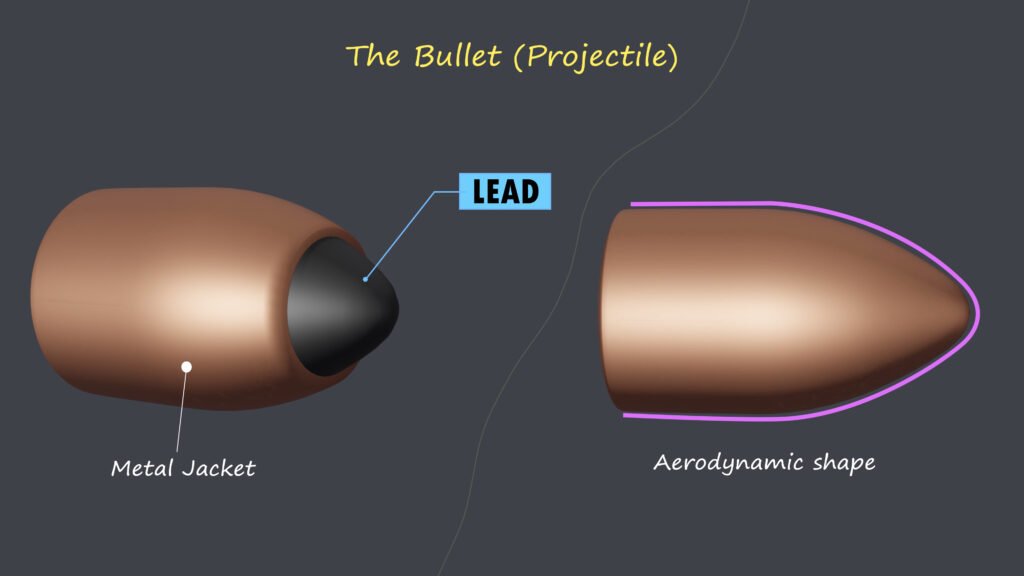
This is the actual part that leaves the gun and travels toward the target.
It’s usually made of lead or a lead alloy, and often coated with a copper jacket to make it smoother and more durable.
The copper jacket helps reduce friction with the barrel and prevents the bullet from deforming under extreme pressure.
Bullets are aerodynamically shaped — often with a pointed or rounded tip — so that they can slice through the air with minimal resistance.
The typical bullet weighs around 7.5 to 9.5 grams, though it varies depending on the caliber and purpose.
Fun Fact: The word “bullet” comes from the French word boulette, meaning “little ball.” Early bullets were literally small round balls of lead!
2. The Casing (Cartridge Case)
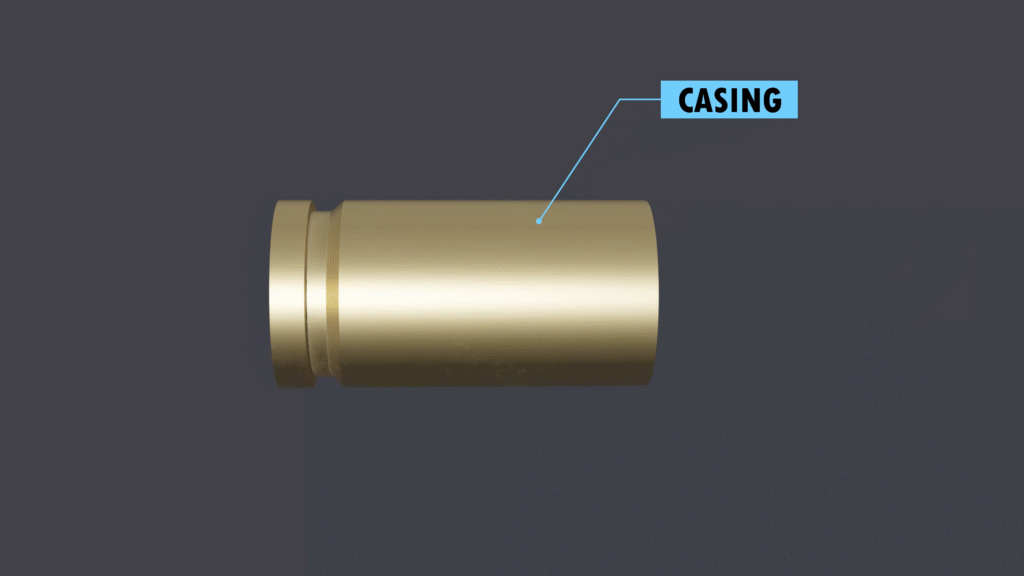
This is the metallic shell that holds everything together.
Usually made from brass, though steel or aluminum casings are also used.
It houses the bullet (projectile) at the front, the propellant (gunpowder) inside, and the primer at the base.
The casing acts as a sealed container so that the explosive gases generated when firing don’t escape backward — they can only push the bullet forward.
Once fired, the empty casing typically stays behind in the gun’s chamber or gets ejected (like you see in action movies, when shells fly out of automatic weapons).
3. The Propellant (Gunpowder)
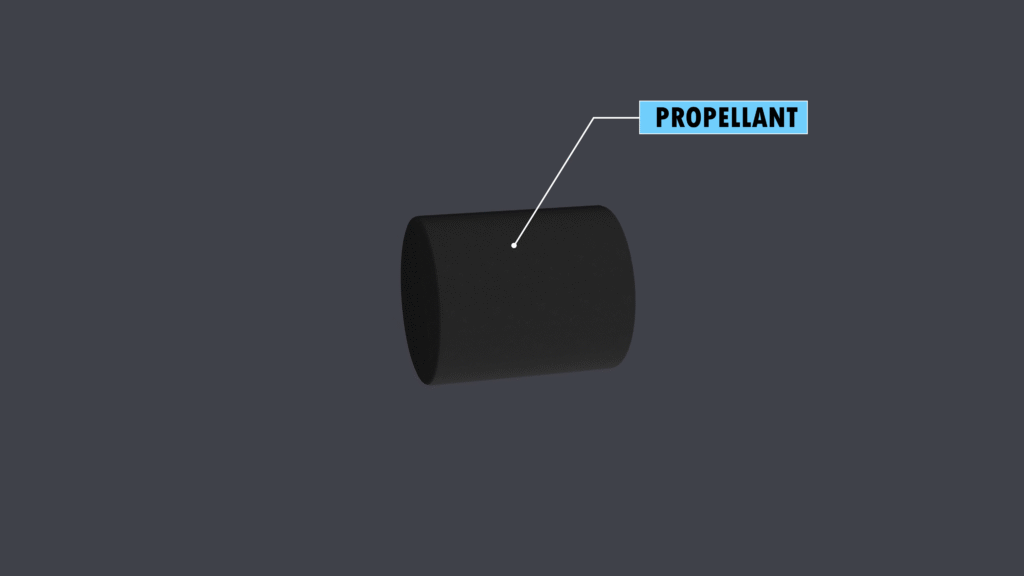
This is the real powerhouse of the cartridge — the fuel that launches the bullet.
In old firearms, people used black powder, a mix of charcoal, sulfur, and potassium nitrate.
Modern ammunition uses smokeless powder, made mostly from nitrocellulose and nitroglycerin.
When ignited, this powder burns extremely fast, creating high-pressure gas that expands inside the casing.
It’s this sudden pressure that pushes the bullet out of the casing and down the barrel.
The amount of propellant varies depending on the bullet’s design — typically between 0.26 and 0.39 grams for common handgun rounds.
Smokeless powder doesn’t actually explode — it burns rapidly in a controlled way. That’s why modern firearms produce much less smoke compared to the old black-powder muskets.
4. The Primer
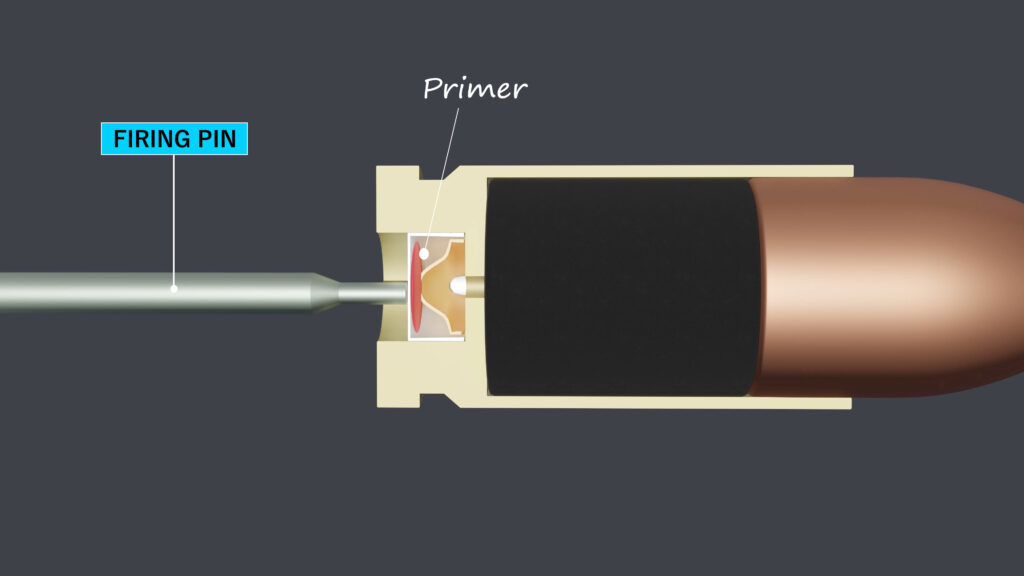
This is the small, sensitive explosive cap at the bottom of the cartridge.
It’s hit by the gun’s firing pin when you pull the trigger.
That tiny impact causes a spark that ignites the propellant inside.
Primers are made of compounds like lead styphnate, barium nitrate, or antimony sulfide — designed to be stable until struck.
Even though it’s the smallest component, the primer is absolutely essential. Without it, there’s no spark, no ignition, and no shot.
How Does a Bullet Fire?
Now that we know what’s inside, let’s see what happens when you actually pull the trigger.
Step-by-Step Process :
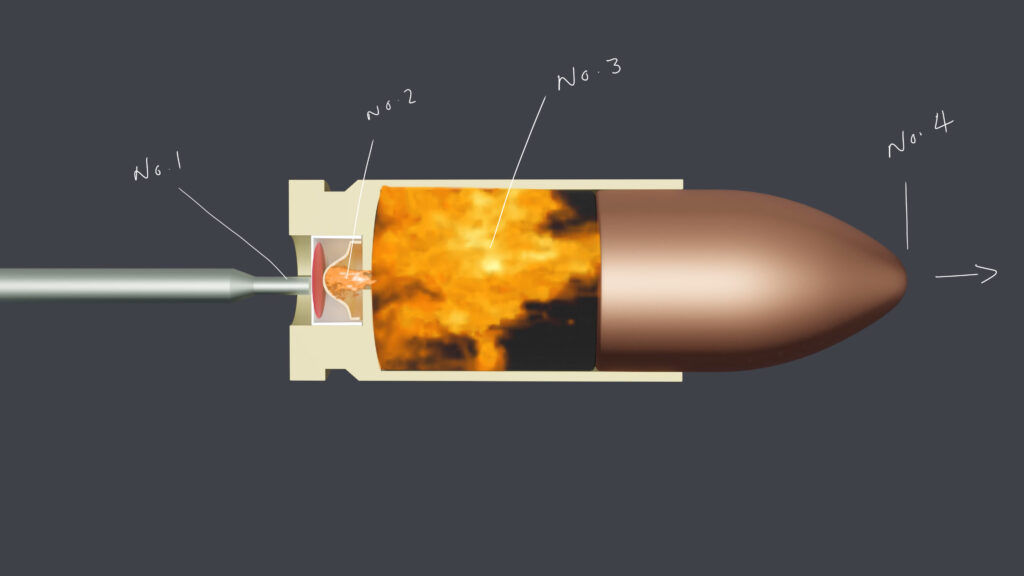
Trigger Pull: When you pull the trigger, it releases a spring-loaded hammer or striker inside the gun.The hammer hits the firing pin, which then strikes the primer on the base of the cartridge.
Ignition: The primer ignites and creates a spark.
Combustion: The spark lights the propellant inside the casing.The burning propellant rapidly produces hot gas, increasing pressure.Gas Expansion: The burning propellant rapidly produces hot gas, increasing pressure.
Ejection: The pressure forces the bullet (projectile) out of the casing and down the barrel.
Exit: The bullet leaves the muzzle (the end of the barrel) at speeds between 300 and 420 meters per second — that’s over 1,000 kilometers per hour!
And all of this happens in less than a fraction of a second.
What Happens After the Bullet Leaves the Barrel?
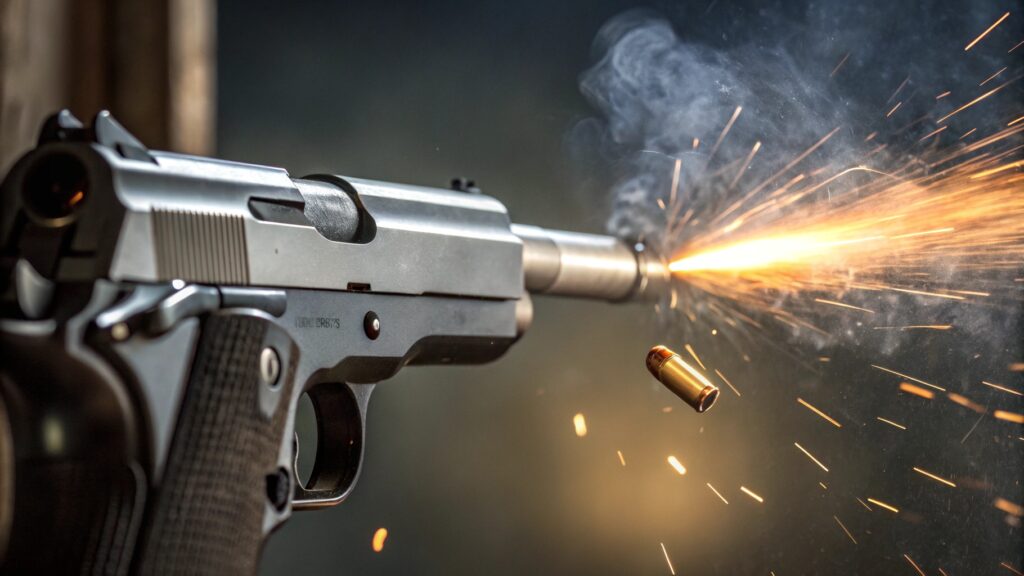
Once the bullet exits the gun, it doesn’t just travel in a straight line forever. Its journey is shaped by physics — gravity, air resistance, and even the rotation caused by the gun barrel.
The Bullet’s Path: The Ballistic Trajectory
The bullet follows a curved path called a ballistic trajectory.
Gravity pulls it downward over distance.
Air resistance slows it down.
Wind can nudge it sideways.
That’s why expert shooters and snipers must carefully calculate distance, wind speed, humidity, and even the Earth’s curvature for long-range shots.
Spin Stabilization – The Secret to Accuracy
Inside the barrel of most guns are spiral grooves called rifling.
These grooves make the bullet spin rapidly as it travels through the barrel.
The spin acts like a gyroscope, keeping the bullet stable in the air.
This prevents the bullet from tumbling and ensures it flies straight toward the target.
Fun Fact: The concept of rifling was first developed in the 15th century, but it didn’t become widespread until the 1800s — revolutionizing firearm accuracy forever.
The Science Behind the Bang
When the propellant burns, it creates gas molecules that expand up to 1,000 times their original volume almost instantly. This rapid expansion is what builds up enormous pressure behind the bullet.
For a typical handgun, the pressure can reach 20,000 to 30,000 pounds per square inch (psi) — that’s enough force to launch the bullet at supersonic speed.
In larger rifles, the pressure can exceed 50,000 psi. That’s why firearms must be made from incredibly strong metals and undergo rigorous testing for safety.
After the Shot: What Happens Inside the Gun
As soon as the bullet exits:
The pressure drops, allowing the gun to cycle and eject the empty casing.
In semi-automatic and automatic firearms, part of the expanding gas or recoil energy is used to load the next round.
In manual guns (like bolt-action rifles or revolvers), you must reload the next round yourself.
The entire firing, ejection, and reloading process is a perfect combination of mechanics and chemistry, all synchronized in milliseconds.
Ballistics – The Science of Bullets
The study of how bullets behave is called ballistics, and it’s divided into three main areas:
Internal Ballistics – What happens inside the gun (the pressure, temperature, and motion before the bullet exits).
External Ballistics – The bullet’s flight through the air (trajectory, drag, wind effects).
Terminal Ballistics – What happens when the bullet hits its target (penetration, deformation, energy transfer).
Each area helps engineers and forensic scientists understand how to make bullets safer, more accurate, and more efficient.
Bullet Firing vs. Cannon Firing – The Same Principle
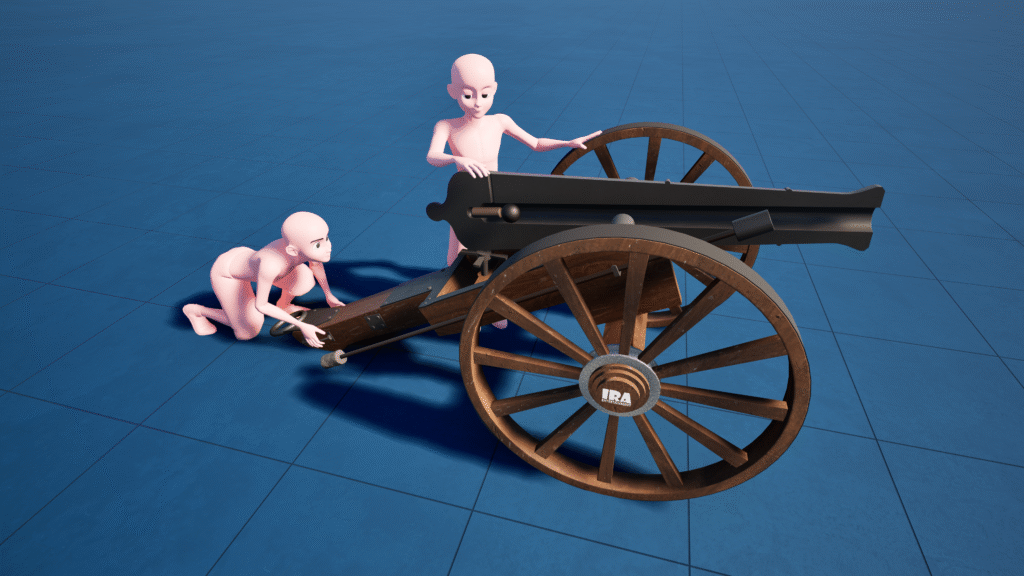
Bullets and cannons work almost identically — the only real difference is scale!
A cannon is just a much larger gun, firing heavier projectiles (called shells) instead of bullets.
Both rely on the same chain of events:
Ignition of propellant → rapid gas expansion → projectile launch.
So, whether it’s a handgun or a historical cannon, the underlying physics remains the same — controlled explosions turned into directed motion.
Bullet Types and Purposes
Not all bullets are the same. The shape, size, and material all depend on what the bullet is designed for.
Common Types:
Full Metal Jacket (FMJ): Standard military and target bullets — designed for accuracy and penetration.
Hollow Point: Has a hollow tip that expands on impact, used in self-defense to stop targets effectively.
Soft Point: Partially jacketed to allow controlled expansion — good for hunting.
Tracer Rounds: Contain a small pyrotechnic charge that glows in flight, allowing shooters to see their trajectory.
Armor-Piercing: Made of hardened steel or tungsten, designed to penetrate hard surfaces.
Each design is a balance between speed, penetration, and safety — tailored for specific uses.
A Brief History of Bullets
Pre-1800s: Early guns fired lead balls, called “musket balls.” Accuracy was poor, and reloading was slow.
Mid-1800s: The invention of the self-contained cartridge revolutionized firearms — combining primer, powder, and projectile in one case.
1900s: Modern metallic cartridges and smokeless powder became the global standard.
Today: Precision manufacturing and advanced materials make bullets incredibly consistent and accurate.
Bullets have evolved from simple lead spheres to precision-engineered tools of defense, sport, and science.
Safety, Responsibility, and Real-World Use
While it’s fascinating to learn about how bullets work, it’s equally important to emphasize safety and responsibility.
Guns and ammunition are not toys — they’re powerful tools designed for specific purposes such as defense, law enforcement, hunting, or sport shooting.
Proper handling, storage, and training are absolutely essential.
Key safety rules:
Always treat every gun as if it’s loaded.
Never point a gun at anything you don’t intend to shoot.
Keep your finger off the trigger until ready to fire.
Be sure of your target and what’s beyond it.
Knowledge of how bullets work isn’t just interesting — it’s vital for safety and respect for firearms.
Modern Innovations in Ammunition
Technology hasn’t stopped evolving. Modern research focuses on making bullets:
More environmentally friendly: Using lead-free materials.
Smarter: Tracking flight data or even adjusting trajectory mid-air (in experimental designs).
Safer: Reduced ricochet risk and more stable storage.
The future of ballistics blends traditional physics with cutting-edge engineering — showing that even ancient inventions can keep evolving.
Conclusion
A bullet is far more than a simple metal object — it’s the result of centuries of innovation and scientific understanding. Each shot represents a finely tuned collaboration between chemistry, physics, and engineering.
From the instant the primer ignites to the moment the projectile cuts through the air, everything happens in perfect precision — pressure, combustion, motion, and balance working together in milliseconds.
The elegance of a bullet lies not in its destructive power, but in the remarkable science that makes it work so flawlessly. It’s a clear reminder that even the smallest mechanisms can reveal the vast intelligence of human design and the raw beauty of physics in motion.
Want to learn more through visual storytelling? Check out our detailed 3D explanation blog on How Cannons Work: Evolution, Engineering, and Impact on Warfare
Useful Link – Bullet
hjuhji
Thanks for the explanation. It really helped. Good explanation with the images 😊